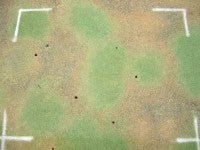GCSAA/USGA Wetting Agent Evaluation
GCSAA/USGA Wetting Agent Evaluation
By Clark Throssell, Ph.D., Director of Research, GCSAA
Start Date: 2003
Project Duration: two years
Total Funding: USGA - $100,000
GCSAA - $100,000
Objectives:
1. To determine the effectiveness of several wetting agents to control localized dry spots on putting greens.
Golf course superintendents often apply wetting agents on putting greens to help manage localized dry spots (LDS). There is limited information available to a superintendent that compares the performance of commonly used wetting agents to manage localized dry spots. The Golf Course Superintendents Association of America (GCSAA), through funding provided by The Environmental Institute for Golf and the United States Golf Association (USGA), is coordinating an evaluation of wetting agents that are frequently used on golf courses. The goal of the wetting agent evaluation is to provide golf course superintendents with unbiased information regarding selected wetting agents so they can make informed use and purchasing decisions.
The specific objective of the evaluation is to determine the effectiveness of several wetting agents to control localized dry spots on putting greens. To meet this objective ten wetting agents most commonly used by superintendents and an untreated control are being evaluated at nine sites across the United States. All ten products are being applied at the highest label rate for control/management of localized dry spot. The nine evaluation sites consist of; bermudagrass research putting greens at the University of Florida-Ft. Lauderdale and Texas A&M University; creeping bentgrass research putting greens at the University of Georgia, Cornell University, Michigan State University and Washington State University-Puyallup; and creeping bentgrass practice greens at golf courses with the research being conducted by scientists from New Mexico State University, Cal State Polytechnic-Pomona and the University of Missouri.
Scientists at all evaluation sites are following the same scientific protocol. Wetting agents are being evaluated over a four-month period of time when stress from LDS is at its peak at that particular evaluation site. Data collected on a regular basis includes turf color, turf quality, phytoxicity and degree of soil hydrophobicity. Soil hydrophobicity is determined using the water droplet penetration test. Soil cores are removed from the plots at prescribed intervals and water droplet penetration time is measured at six depths below the soil surface and recorded. The evaluation will be conducted in 2003 and 2004.
Creeping bentgrass greens in the evaluation are mowed at a maximum height of 140/1,000ths inch at least six days per week and bermudagrass greens in the evaluation are mowed at a maximum height of 156/1,000ths of an inch at least six days per week. Cultivation that penetrates the soil surface is not allowed during the evaluation period. All other maintenance practices necessary to produce a high quality putting green are permitted and must be recorded.
Prior to the initiation of the GCSAA/USGA Wetting Agent Evaluation it was agreed that in fairness to all products being evaluated no preliminary results would be published. Final results will be published in early 2005. Data from all sites will be published along with a complete record of maintenance practices for that site. No recommendations will be made. Superintendents and other interested people can review the data for the site that most closely approximates their golf course and use the information to make sound wetting agent use and purchasing decisions.
Summary Points:
- Ten wetting agents most commonly used by superintendents and an untreatedcontrol are being evaluated at nine sitesacross the United States. All ten products
are being applied at the highest label ratefor control/management of localized dryspot. - Wetting agents are being evaluated over a four-month period of time when stress from LDS is at its peak at that particular evaluation site. Data to be collected
on a regular basis includes turf color, turf quality, phytoxicity,and degree of soil hydrophobicity. - Final results will be published in early 2005. Data from all sites will be published along with a complete record of maintenance
practices for that site.
2003 USGA Turfgrass and Environmental Research summary.
Reproduced with kind permission of USGA Turfgrass and Environmental Research Program.
For further information you can visit www.usga.org
